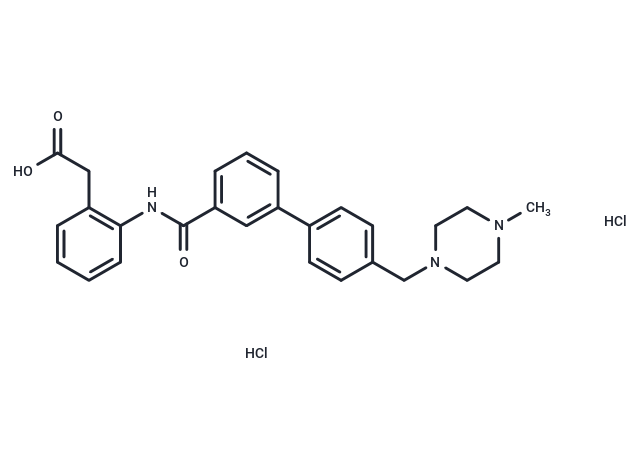Shopping Cart
Remove All Your shopping cart is currently empty
Your shopping cart is currently empty
NF-56-EJ40 hydrochloride is a potent, high-affinity, and highly selective human SUCNR1 (GPR91) antagonist with an IC50 of 25 nM and a Ki of 33 nM, and shows almost no activity towards rat SUCNR1. NF-56-EJ40 hydrochloride has high affinity for humanized rat SUCNR1 with a Ki value of 17.4 nM.

| Pack Size | Price | USA Warehouse | Global Warehouse | Quantity |
|---|---|---|---|---|
| 5 mg | $50 | In Stock | In Stock | |
| 10 mg | $75 | In Stock | In Stock | |
| 25 mg | $128 | In Stock | In Stock | |
| 50 mg | $192 | In Stock | In Stock | |
| 100 mg | $287 | In Stock | In Stock | |
| 200 mg | $431 | - | In Stock |
| Description | NF-56-EJ40 hydrochloride is a potent, high-affinity, and highly selective human SUCNR1 (GPR91) antagonist with an IC50 of 25 nM and a Ki of 33 nM, and shows almost no activity towards rat SUCNR1. NF-56-EJ40 hydrochloride has high affinity for humanized rat SUCNR1 with a Ki value of 17.4 nM. |
| In vitro | NF-56-EJ40 hydrochloride is bound deep inside the hydrophobic pocket, with the acid group coordinated by the hydroxyl groups of the conserved residues Y832.64 and Y301.39 on one side, and R2817.39 on the other side. The conserved E181.27 is predicted to form an additional hydrogen bond to the piperazine ring of NF-56-EJ40 hydrochloride. E221.31 and N2747.32 in human SUCNR1 are replaced by K181.31 and K2697.32 in rat SUCNR1. These two amino acid exchanges could prevent the binding of NF-56-EJ40 hydrochloride to rat SUCNR1 owing to steric hindrance. Radioligand-binding studies with human SUCNR1 showed partial agreement with our homology model: the Y301.39F mutant of human SUCNR1, shows reduced binding of NF-56-EJ40. Similar effects are observed with the E181.27K and E181.27R mutants, probably owing to steric clashes of the Lys and Arg residues with NF-56-EJ40 hydrochloride and the loss of a hydrogen bond to its piperazine ring[1]. Human SUCNR1 residues are introduced into rat SUCNR1 to form the double mutant K181.31E/K2697.32N (hereafter denoted humanized rat SUCNR1) (Ki of 17.4 nM and 33.5 nM for human and humanized rat SUCNR1, respectively). NF-56-EJ40 hydrochloride increases the thermal stability of both humanized rat SUCNR1 and human SUCNR1, but not that of rat SUCNR1[1]. |
| Molecular Weight | 516.46 |
| Formula | C27H31Cl2N3O3 |
| Cas No. | 2728500-80-7 |
| Smiles | O=C(CC1=C(NC(C2=CC=CC(C3=CC=C(CN4CCN(CC4)C)C=C3)=C2)=O)C=CC=C1)O.Cl.Cl |
| Relative Density. | no data available |
| Storage | Powder: -20°C for 3 years | In solvent: -80°C for 1 year | Shipping with blue ice/Shipping at ambient temperature. | ||||||||||||||||||||
| Solubility Information | DMSO: 5.19 mg/mL (10.05 mM), Sonication is recommended. | ||||||||||||||||||||
Solution Preparation Table | |||||||||||||||||||||
DMSO
| |||||||||||||||||||||
| Size | Quantity | Unit Price | Amount | Operation |
|---|

Copyright © 2015-2025 TargetMol Chemicals Inc. All Rights Reserved.